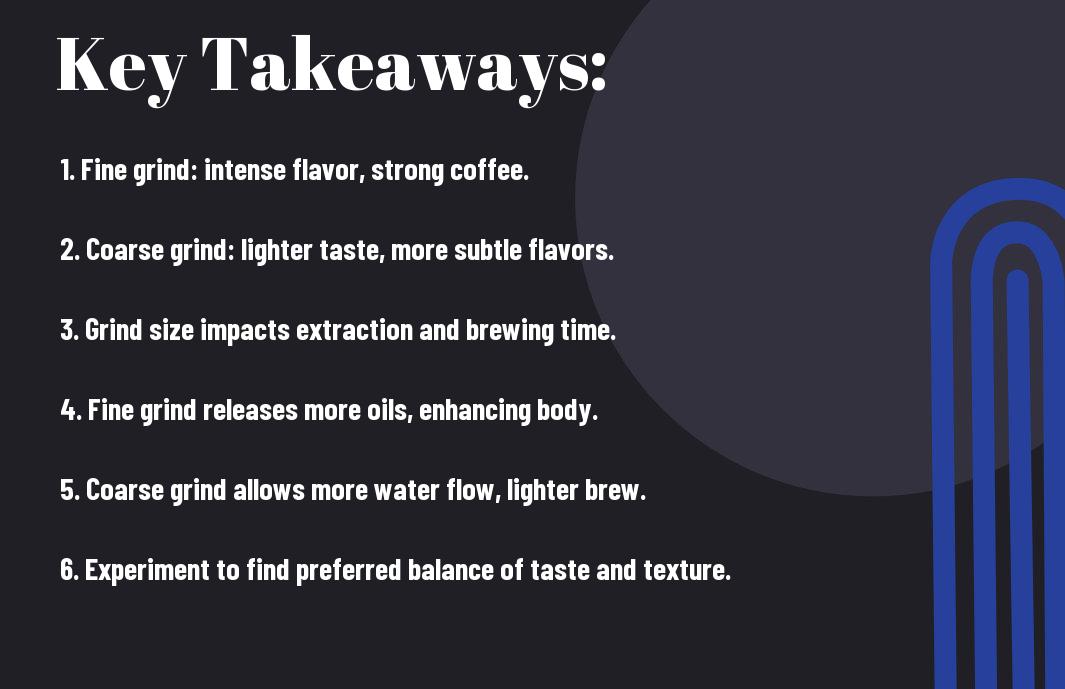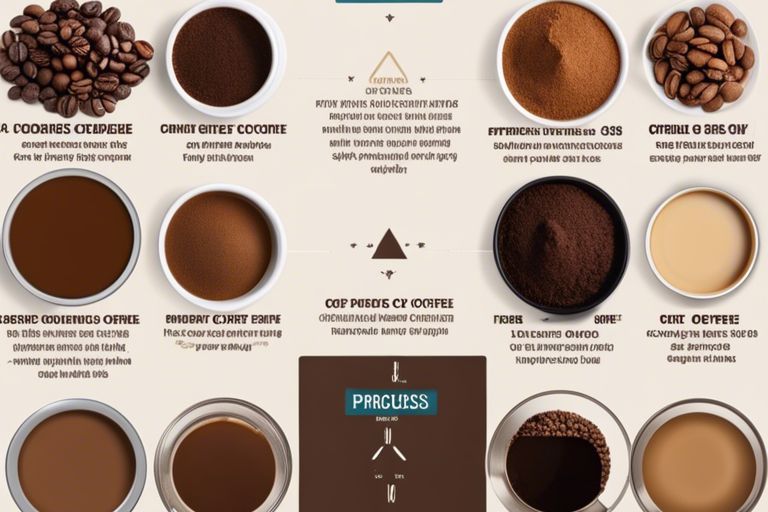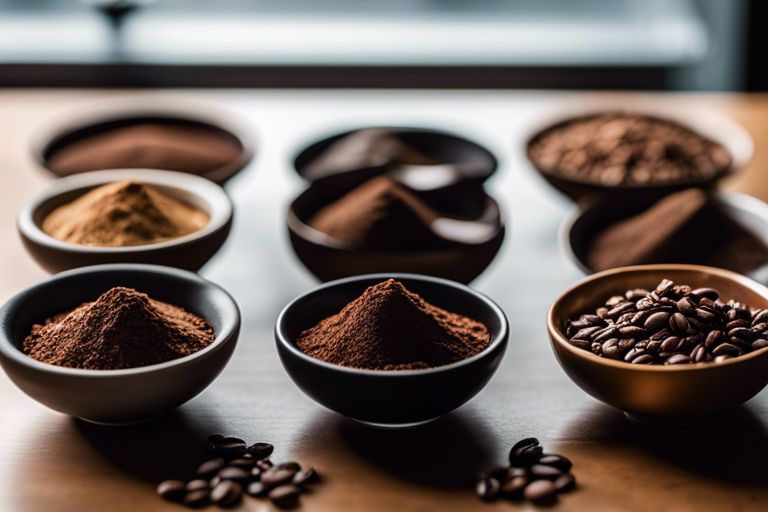Most coffee enthusiasts understand the significance of grind size in brewing the perfect cup. From fine to coarse, the grind size can drastically impact the flavor profile of your coffee. In this insightful exploration, we will probe into the intricate relationship between grind size and taste, uncovering how the size of your coffee grounds can unlock a world of flavor nuances and complexities. Join us as we unravel the mysteries behind the art of grinding coffee beans.
Key Takeaways:
- Coarser grind size: Produces a weaker, more acidic flavor profile due to faster extraction and less overall surface area for flavor extraction.
- Finer grind size: Yields a stronger, more bitter taste as it allows for quicker and more thorough extraction, potentially resulting in over-extraction if not monitored carefully.
- Medium grind size: Strikes a balance between the two extremes, offering a well-rounded flavor profile that extracts the desired compounds without excessive bitterness or acidity.
- Consistent grind size: Ensures uniform extraction of flavors, preventing uneven extraction which can lead to an imbalanced taste in the final cup of coffee.
- Experimentation is key: Taste preferences can vary widely, so don’t be afraid to adjust grind size to find the perfect balance that suits your personal taste preferences.

The Basics of Coffee Grinding
While Why Coffee Grind Size Matters provides a detailed exploration of the impact of grind size on the final cup of coffee, let’s research into the basics of coffee grinding here.
What is grind size?
Coffee grind size refers to the level of fineness or coarseness at which the coffee beans are ground. The grind size plays a crucial role in the flavor extraction process when brewing coffee. Different brewing methods require different grind sizes to achieve the desired taste profile.
Types of grind sizes
To optimize the flavor extraction process, it is necessary to use the correct grind size for your preferred brewing method. Here are some common grind sizes and their recommended uses:
| Grind Size | Recommended Brewing Method |
|---|---|
| Extra Coarse | Cold Brew |
| Coarse | French Press |
| Medium | Drip Coffee Makers |
| Fine | Espresso Machines |
| Extra Fine | Turkish Coffee |
When dicking out the grind size, consider the method of extraction, water contact time, and desired flavor profile. The right grind size ensures optimal extraction, leading to a flavorful and well-balanced cup of coffee.
The Science Behind Grind Size and Taste
Extraction rates and flavor compounds
You may wonder how something as simple as grind size can significantly impact the taste of your coffee. Well, it all comes down to extraction rates and flavor compounds. When hot water passes through coffee grounds, it extracts various compounds that give coffee its flavor. The finer the grind, the larger the surface area, and the faster the extraction process. This can result in over-extraction, leading to a bitter and harsh taste. Conversely, coarser grinds have a smaller surface area, leading to under-extraction and a weak, sour taste.
How grind size affects brewing methods
Science plays a crucial role in understanding how grind size affects different brewing methods. For example, espresso machines require a fine grind to ensure proper extraction in a short amount of time. On the other hand, methods like French press or cold brew benefit from a coarser grind to achieve a balanced extraction over a longer steeping period. The size and consistency of the grind also influence factors such as water flow rate and contact time, ultimately impacting the final flavor profile of your coffee.
Rates of extraction are influenced by the grind size, which determines how quickly water can penetrate the coffee grounds and extract flavorful compounds. Finding the right balance is key to achieving a delicious cup of coffee that highlights the nuances of the beans without any unpleasant bitterness or sourness.

Coarse Grinds: The Benefits and Drawbacks
Advantages of coarse grinds
For those seeking a unique and flavorful coffee experience, coarse grinds offer a distinct advantage. The larger particle size allows water to flow through the grinds more quickly, resulting in a shorter brewing time. This can be particularly appealing for individuals who prefer a milder taste profile in their coffee. Coarse grinds are also less likely to over-extract, reducing the bitterness sometimes associated with finer grinds.
Disadvantages of coarse grinds
With coarse grinds, there are some drawbacks to consider. The faster brewing time can lead to less extraction of flavors from the coffee grounds, resulting in a lighter or weaker taste. Additionally, the coarser particles may not fully dissolve during the brewing process, potentially leaving sediment in the cup. This can affect the overall clarity and mouthfeel of the coffee, detracting from the desired experience.
Understanding the balance between grind size and brewing time is key when working with coarse grinds. While they offer a quicker brewing process and a potentially milder taste, it’s important to experiment and find the right combination to achieve the desired flavor profile. Adapting brewing methods and adjusting variables such as water temperature and extraction time can help mitigate some of the disadvantages associated with coarse grinds, allowing coffee enthusiasts to tailor their brew to perfection.
Fine Grinds: The Benefits and Drawbacks
Advantages of fine grinds
Unlike coarser grinds, fine grinds have their own set of advantages when it comes to brewing coffee. Fine grinds are perfect for espresso machines as they allow for greater extraction of flavors in a short amount of time. The fine particles increase the surface area of the coffee grounds, resulting in a robust and full-bodied cup of coffee.
Disadvantages of fine grinds
Fine grinds, while beneficial for certain brewing methods, can also pose some challenges. One of the main drawbacks of using a fine grind is the potential for over-extraction. Since the particles are smaller, the water can pass through them more quickly, leading to a bitter and unpleasant taste. Additionally, fine grinds can clog filters in methods like pour-over or French press, affecting the overall brewing process.
Over-extraction with fine grinds can result in a bitter and astringent coffee, overshadowing the nuances of the beans’ flavors. It requires precise brewing techniques and equipment to control the extraction time and ensure a balanced and enjoyable coffee experience.
Medium Grinds: The Sweet Spot?
Many coffee enthusiasts consider medium grinds to be the sweet spot when it comes to brewing the perfect cup of coffee. Medium grinds are versatile enough to be used in various brewing methods, such as drip coffee makers, pour-over, and Aeropress. These grinds strike a balance between the coarser grinds, which can result in under-extraction, and finer grinds, which can lead to over-extraction and a bitter taste.
The optimal grind size for brewing
Sweet and flavorful, medium grinds allow for a more even extraction of coffee grounds, resulting in a well-rounded cup of coffee. The medium grind size ensures that the water interacts with the coffee grounds just right, extracting the optimal amount of flavor compounds without causing bitterness.
Balancing flavor and body
On the other hand, medium grinds also offer a good balance between flavor and body. While finer grinds may enhance the flavors but sacrifice body, and coarser grinds may bring out a fuller body but lack in flavor complexity, medium grinds strike the perfect equilibrium between the two.
Grinds of medium size are like the Goldilocks of coffee brewing – not too fine, not too coarse, but just right for extracting a delicious and well-rounded cup of coffee.

Grind Size and Brewing Methods
Once again, the grind size of coffee beans plays a crucial role in determining the flavor profile of the final brew. Different brewing methods require specific grind sizes to extract the best flavors from the coffee beans. Let’s explore how various brewing methods are impacted by grind size.
Drip Brewing and Grind Size
The grind size for drip brewing is typically medium, similar to kosher salt. A consistent grind size is vital for this method to ensure even extraction. If the coffee grounds are too fine, it can result in over-extraction and a bitter taste. On the other hand, if the grind is too coarse, the extraction may be uneven, leading to a weak and underwhelming cup of coffee.
French Press and Grind Size
On the other hand, French press brewing method works best with a coarse grind size, resembling breadcrumbs. The coarse grind allows for a longer steeping time without over-extracting the coffee, resulting in a full-bodied and robust flavor profile.
Plus, a coarse grind size also prevents the fine particles from passing through the filter of the French press, giving you a clean cup of coffee with rich flavors and aromatic oils.
Espresso and Grind Size
French press requires a much coarser grind compared to espresso, where a fine grind size similar to table salt is preferred. The fine grind allows for a quick and intense extraction process in an espresso machine, producing a concentrated and flavorful shot of coffee with a layer of crema on top.
Size adjustments in espresso grinding are crucial as even a slight change in grind size can significantly impact the extraction time and the overall taste of the espresso shot.
To wrap up
Conclusively, the grind size plays a crucial role in determining the taste of coffee. As discussed in the article “Grind size and how it affects your brew,” the size of the coffee grounds can significantly impact the extraction process and, ultimately, the flavor profile of the final cup. Different grind sizes produce different levels of extraction, affecting the balance of acidity, body, and overall taste of the coffee. It is necessary for coffee enthusiasts to experiment with various grind sizes to find the perfect balance and achieve their desired flavor profile.
FAQ
Q: How does grind size affect the taste of coffee?
A: The grind size of coffee beans plays a crucial role in determining the flavor profile of your brew. Different grind sizes extract flavors differently, impacting the taste and overall quality of your coffee.
Q: What is the relationship between grind size and extraction?
A: Grind size affects the surface area of the coffee grounds exposed to water during brewing. Finer grinds have more surface area, leading to quicker extraction, while coarser grinds result in slower extraction.
Q: How does a fine grind size influence the taste of coffee?
A: Fine grind sizes, like those used for espresso, extract flavors quickly and result in a rich, intense cup of coffee with a bold taste and a higher level of acidity.
Q: What about coarse grind sizes and their impact on coffee taste?
A: Coarse grind sizes, typical of French press or cold brew methods, extract flavors slowly and produce a milder, smoother cup of coffee with lower acidity and a fuller body.
Q: How can I adjust the grind size to achieve the desired coffee flavor?
A: Experiment with different grind sizes to find the perfect balance for your taste preferences. Be mindful of, finer grinds for a stronger, more intense flavor, and coarser grinds for a milder, smoother taste.
What are the origins of coffee
How much caffeine is in a cup of coffee
Unlocking the Mystique – Exploring the Rich Flavor Profile of Black Coffee





